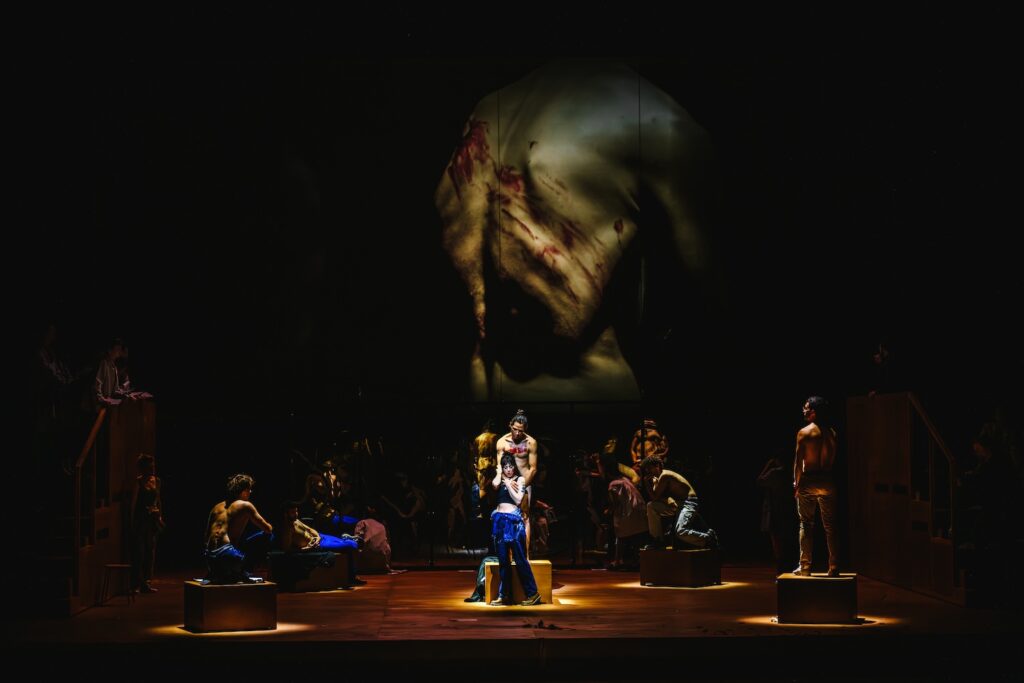Ossia Cosi fan tutti, as you never could have possibly imagined it.
French stage director Marie-Éve Signeyrole flipped the opera’s two titles, setting the second of the Mozart / DaPonte trilogy in a university lecture hall — let’s say that it’s still in Naples, though Italian baritone, Pesaro finished Simone Del Savio [lead photo, top] lectured us (extensive interpolated speeches) in fine Roman Tuscan (high Italian), while he lectured 20 young Lyonnaise couples seated in the lecture hall about the vagaries and inconstancies of love, provoking the well known challenge to the students.
Welsh tenor, Lyon Opera Studio finished Robert Louis (Ferrando) came forward, as did Russian born, Bolshoi finished baritone Ilya Kutyukhin (Guglielmo). and then emerged Oman born, Indiana University finished mezzo-soprano Deepa Johnny (Dorabella) [lead photo, bottom], as did Bulgarian born, Juilliard finished soprano Tamara Banješeviċ (Fiordiligi) [lead photo, middle]. All in the casual, clumsy, impromptu dress of contemporary university students.
But wait! How did Mme. Signeyrole stage the entrance of the Albanian soldiers? The university students, donning white smocks, had moved to a life drawing class where a number of nude male models posed on pedestals. Ferrando and Guglielmo, among the models, were discreetly not entirely nude, though enough to confuse the girls. The guys drank poison from a thermos, a playful student named Despina, Mannheim born, Lyon Opera Studio finished soprano Giulia Scopelliti came forward to revive them with a truly menacing hypodermic syringe.
Stage director Signeyrole makes much use of well integrated video, a videographer is sometimes present who projects close up images on discretely placed, large and small stage screens. Other times there was a huge screen backdrop that served to display vertically what is horizontally strewn on the floor — a signature Signeyrole technique, here it was 20 supine Lyonnaise couples embracing. Mme. Signeyrole’s video served also as a moving backdrop behind bicycles that were peddling off to war, this during the first act chorus “La bella vita militar” — the chorus well hidden behind five bright bicycle headlights in our eyes.

After the intermission, the female students came together in a Despina led food laboratory, where very ripe and very colorful fruits and vegetables were displayed, and intermingled videographically with playful erotic imagery, while Despina encouraged the young women, one and all, to partake freely of the pleasures of life.
Mme. Signeyrole’s Cosi fan tutte was total and complete magic! Though the second act still got long, and as usual there more Despina than you wanted.
The final image were the six principals in their grand finale ensemble, furtively moving here and there, always alone on a revolving stage. We saw, quite graphically, that it is very dangerous, and cruel to play with human emotions.
The magic did not stop with the staging. British conductor Duncan Ward set delightful tempos that kept up and encouraged the playful staging, tempos that were sometimes in an elevated briskness, sometimes sharpening the rhythms that we are [so very] used to. But never did the maestro lose track of the stage — there was a perfect synergy of pit to stage. Interestingly the maestro kept the string sound well below the woodwinds (flutes, clarinets, oboes, bassoons) that strongly brought forth the myriad colors of the score. Fortepiano was the continuo instrument.
The Opéra de Lyon is one of the more progressive stages in Europe. Its audience is well attuned to the importance of maintaining a dramaturgical tension in the staging of an opera, rather then focusing on individual performative moments, i.e applauding a well sung aria. While this is certainly disconcerting for someone not initiated into Lyonnaise operatic protocol, one quickly and appreciatively adapts.
But the audience on June 18 could not help themselves. Applause broke out after Fiordiligi’s “Come scoglio,” sung with brutal resolve in very clear voice by soprano Tamara Banješeviċ, and broke out again after Ferrando’s “Ah, lo veggio, quell’anima bella,” sung in wrenchingly soft despair by tenor Robert Lewis.

The youth of the cast brought infectious energy to the performance, and an appreciation of the accomplishments of the young artist programs around the world. The entire cast exhibited solid technique, knowing stage presence, and carefully applied musicianship. Conductor Duncan Ward as well had preparation at the Karajan Academy of the Berlin Philharmonic, a protege of Simon Rattle.
The extensive video was created by Marie-Éve Signeyrole, Strasburg designer Fabien Teigné imagined the sets and costumes. The effective lighting was by Strasburg designer Philippe Berthomé. French dramaturg Louis Gelsier oversaw the transposition of Cosi to the university setting, as he had of Vincent Huguet’s transposition of Massenet’s Manon from 1731 to 1924, playing simultaneously at the Opéra Bastille in Paris (see my review just beside this review).
Michael Milenski
Opéra Nouvel, Lyon, France, June 18, 2025
All photos copyright Paul Bourdrel, courtesy of the Opera national de Lyon.